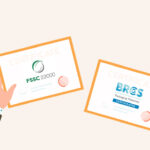Introduction
Packaging plays a big role in many industries. It keeps products safe, makes them easy to carry, and helps them look good on the shelves. When choosing the right packaging, businesses need to think about the type of bag that will work best for their products.
Two popular types of bags are block bottom bags and traditional bags. Block bottom bags have a flat bottom that helps them stand upright, making them great for products like grains or snacks. Traditional bags come in different styles, like flat or gusseted, and are often used for various items.
In this blog, we will look at the differences between block-bottom bags and traditional bags. Our goal is to help you decide which type of bag is the best choice for your needs. Let’s dive in
What are Block Bottom Bags?
Block bottom bags are a type of bag designed to stand up on their own. They have a flat bottom that provides stability and makes them easy to fill. This design helps the bags stay upright, so the contents are visible and accessible.
These bags can be made from different materials. Common options include:
- Polypropylene: This plastic is strong and lightweight, making it a popular choice for many products.
- Paper: Often used for eco-friendly packaging, paper block bottom bags can hold various items and can be printed with designs.
- Plastic: Other types of plastic can also be used, offering durability and flexibility.
Block bottom bags are typically used for various products. You often see them in grocery stores for items like snacks, grains, and pet food. They are also used for packaging in the baking industry, like flour or sugar, because their shape makes them easy to stack and store. Overall, block bottom bags are practical for many needs!
What are Traditional Bags?
Traditional bags are a common type of packaging used for many products. They come in various styles, with the two most common being flat bags and gusseted bags.
- Flat Bags: These bags are simple and made from a single piece of material. They are open at the top and are often used for lightweight items. Flat bags can be sealed or left open, depending on the product.
- Gusseted Bags: These bags have extra material on the sides, called gussets. This extra space allows the bag to expand, making it suitable for bulkier items. Gusseted bags can hold more than flat bags and are often used for snacks, clothing, or other products that need more room.
Traditional bags are made from various materials, including:
- Plastic: Many traditional bags are made from plastic, which is lightweight and waterproof.
- Paper: Paper bags are eco-friendly and often used for grocery items or takeout food.
- Fabric: Some reusable bags are made from cloth or other fabrics, making them durable and washable.
You can find traditional bags in many places. They are widely used in grocery stores, retail shops, and restaurants. They are a versatile choice for packaging everything from food to clothing. Overall, traditional bags are essential for many industries because they are easy to use and cost-effective.
Key Differences Between Block Bottom Bags and Traditional Bags
Structure and Design
- Block Bottom Bags: Block bottom bags feature a unique design with a flat base, allowing them to stand upright. This design makes it easy to fill them with products and ensures they display well on shelves. The flat bottom keeps the bag stable, which is helpful for showcasing items to customers.
- Traditional Bags: Traditional bags come in various styles, such as flat and gusseted bags. Flat bags are simple and do not have any extra structure, while gusseted bags have side panels that allow for expansion. However, these bags may not stay upright on their own unless filled properly, which can make them less convenient for certain products.
Capacity and Stability
- Block Bottom Bags: Block bottom bags provide excellent stability and capacity. Their design allows them to hold more weight without tipping over. This makes them suitable for bulkier items like grains, snacks, and pet food. The flat bottom ensures that the weight is evenly distributed, preventing spills.
- Traditional Bags: Traditional bags typically have less capacity compared to block bottom bags. While gusseted bags can expand to hold more, flat bags may struggle with heavier items. They can easily tip over if not filled properly, which can lead to spills and messes. This limits their use for certain products that require more stability.
Appearance and Branding Opportunities
- Block Bottom Bags: Block bottom bags offer great visibility for branding. Their upright design allows for clear display of logos and designs on the front, making it easier for customers to see the brand. This eye-catching feature can help attract more attention on store shelves, leading to increased sales.
- Traditional Bags: Traditional bags can also feature branding, but they may not display logos as effectively as block bottom bags. While flat bags can be printed with designs, they lay flat and may not showcase the brand prominently. Gusseted bags provide a bit more surface area but still might not stand out as much as block bottom bags.
Eco-Friendliness
- Block Bottom Bags: Block bottom bags can be eco-friendly if made from sustainable materials like paper or recyclable plastic. Many brands choose these materials to appeal to environmentally conscious consumers. The ability to recycle or reuse these bags can help reduce environmental impact.
- Traditional Bags: Traditional bags can also be eco-friendly, especially if they are made from recycled materials or biodegradable options. The sustainability of these bags depends on the materials used. Brands focusing on eco-friendliness should consider the environmental impact of their packaging choices, whether using traditional or block bottom bags.
Advantages of Block Bottom Bags
Enhanced Load-Bearing Capacity
Block bottom bags are designed to hold more weight than many other bag types. Their flat bottom allows for even weight distribution, which means they can carry heavier items without breaking or tipping over. This makes them ideal for packaging products like grains, snacks, and pet food. Businesses can trust these bags to keep their products safe and secure.
Easier Filling and Handling
Filling block bottom bags is simple and quick. Because they stand upright, it is easy to pour or scoop products into them without making a mess. This efficiency helps save time during packaging. Handling these bags is also easy, as their stable base allows for comfortable stacking and transport. Workers can move them without worrying about spills.
Improved Shelf Presence
Block bottom bags stand upright on store shelves, which gives them a better appearance. This visibility helps grab the attention of shoppers, making products more appealing. When customers can see the packaging and branding clearly, they are more likely to choose those items. A strong shelf presence can lead to increased sales and brand recognition.
Choosing the Right Bag for Your Needs
When it comes to choosing the right bag for your products, there are several factors to consider. These factors can help you decide which type of bag is best for your needs.
1. Product Type and Weight
Think about what you are packaging. If your product is heavy or bulky, block bottom bags are the better option. Their strong design can hold more weight without breaking. For lighter items, traditional bags may work, but they may not offer the same stability.
2. Branding Needs
How you want your product to look on the shelf is also important. Block bottom bags stand upright, giving your brand more visibility. If you want your logo to catch the eyes of shoppers, block bottom bags are a great choice. Traditional bags can be printed too, but they may not showcase your brand as well since they lay flat.
3. Filling and Handling
Consider how easy it is to fill and handle the bags. Block bottom bags make filling quick and simple because they can stand on their own. If your team needs to package items quickly, these bags can save time. Traditional bags can be a bit more challenging to fill without making a mess.
Scenarios for Each Type
- When to Choose Block Bottom Bags: If you are packaging heavier products like grains, snacks, or pet food, block bottom bags are the best choice. Their enhanced load-bearing capacity and easy handling make them ideal for these types of items. Additionally, if you want your product to stand out on the shelf, these bags are the way to go.
- When Traditional Bags Might Be Enough: Traditional bags may be suitable for lightweight items like small candies or promotional giveaways. However, keep in mind that they may not provide the same level of stability and visibility as block bottom bags.
Choosing the right bag type depends on your product’s needs, weight, and how you want your brand to be seen. Block bottom bags offer enhanced stability, capacity, and a stronger shelf presence, making them an excellent choice for heavier or bulkier items. Traditional bags are versatile but may not provide the same level of support or visibility. By understanding the strengths of each option, you can make an informed decision that best suits your business.
At Anita Plastics, we offer a wide range of packaging solutions, including high-quality block bottom bags. We invite you to explore our products or reach out for customized packaging solutions.




